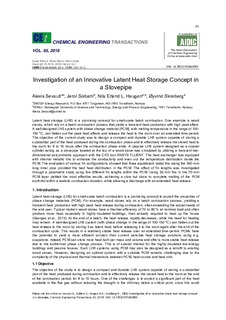| dc.contributor.author | Sevault, Alexis | |
| dc.contributor.author | Soibam, Jerol | |
| dc.contributor.author | Haugen, Nils Erland L | |
| dc.contributor.author | Skreiberg, Øyvind | |
| dc.date.accessioned | 2019-02-12T14:42:43Z | |
| dc.date.available | 2019-02-12T14:42:43Z | |
| dc.date.created | 2018-06-05T14:55:41Z | |
| dc.date.issued | 2018 | |
| dc.identifier.citation | Chemical Engineering Transactions. 2018, 65 25-30. | nb_NO |
| dc.identifier.issn | 1974-9791 | |
| dc.identifier.uri | http://hdl.handle.net/11250/2585078 | |
| dc.description.abstract | Latent heat storage (LHS) is a promising concept for small-scale batch combustion. One example is wood stoves, which rely on a batch combustion process that yields a transient heat production with high peak effect. A well-designed LHS system with phase change material (PCM), with melting temperature in the range of 100-150 °C, can flatten out the peak heat effects and release the heat to the room over an extended time-period. The objective of the current study was to design a compact and durable LHS system capable of storing a substantial part of the heat produced during the combustion phase and to effectively release the stored heat to the room for 6 to 10 hours after the combustion phase ends. A passive LHS system designed as a coaxial cylinder acting as a stovepipe located at the top of a wood stove was simulated by utilizing a transient two-dimensional axisymmetric approach with the CFD tool ANSYS FLUENT. The heat exchanger was equipped with internal metallic fins to enhance the conductivity and even out the temperature distribution inside the PCM. Various fin configurations were evaluated and it was found that configurations with three equidistant radial fins along the 300-mm long inner pipe provided the best heat distribution in the PCM. The effect of fin lengths was investigated through a parametric study using five different fin lengths within the PCM. Using 35-mm fins in the 70-mm PCM layer yielded the most effective results, achieving a slow but close to complete melting of the PCM erythritol within a realistic combustion duration, while allowing a discharge with an extended heat release. | nb_NO |
| dc.description.abstract | Investigation of an Innovative Latent Heat Storage Concept in a Stovepipe | nb_NO |
| dc.language.iso | eng | nb_NO |
| dc.publisher | AIDIC | nb_NO |
| dc.rights | Attribution-NonCommercial-NoDerivatives 4.0 Internasjonal | * |
| dc.rights.uri | http://creativecommons.org/licenses/by-nc-nd/4.0/deed.no | * |
| dc.title | Investigation of an Innovative Latent Heat Storage Concept in a Stovepipe | nb_NO |
| dc.type | Journal article | nb_NO |
| dc.type | Peer reviewed | nb_NO |
| dc.description.version | publishedVersion | nb_NO |
| dc.source.pagenumber | 25-30 | nb_NO |
| dc.source.volume | 65 | nb_NO |
| dc.source.journal | Chemical Engineering Transactions | nb_NO |
| dc.identifier.doi | 10.3303/CET1865005 | |
| dc.identifier.cristin | 1589157 | |
| dc.relation.project | SINTEF Energi AS: 5020001554 | nb_NO |
| dc.relation.project | Norges forskningsråd: 243752 | nb_NO |
| cristin.unitcode | 7548,70,0,0 | |
| cristin.unitname | Termisk energi | |
| cristin.ispublished | true | |
| cristin.fulltext | original | |
| cristin.qualitycode | 1 | |

